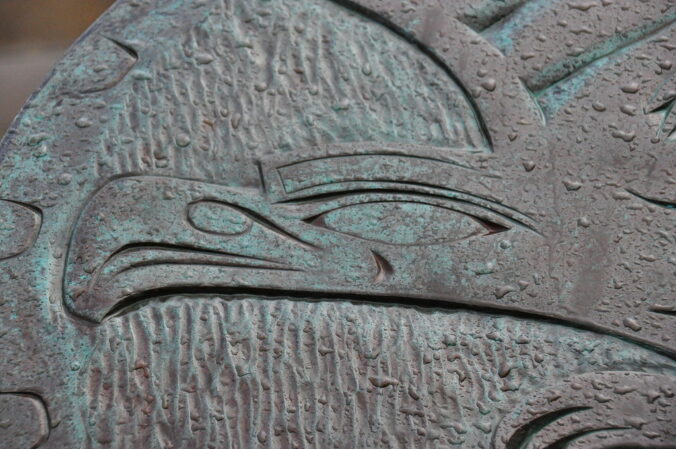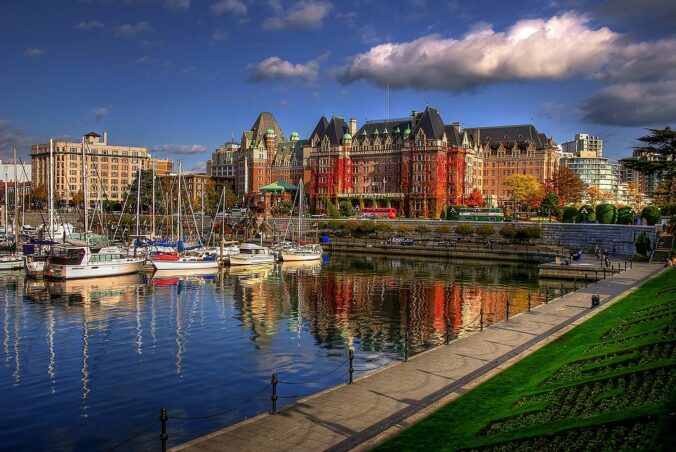On this third week of learning about Victoria, I wanted to stay with the topic of the Indigenous nations here. However, I wanted to refocus my attention away from the history of colonialism, and look at the ways those nations were asserting their rights and culture today. All too often in education, Indigenous peoples are talked through exclusively through a victim narrative, that erases their agency and the meaningful impacts they have made and continue to make. This narrative also perpetuates a doom and gloom outlook, in which we ignore the positive strides that have been made; sharing these stories helps inspire hope, which is a necessary precursor to action. I hope in my classroom to investigate and center the efforts of the Lekwungen, the WSANEC, and other Indigenous groups.
One great example of this is the “Signs of Lək̓ʷəŋən“, a project that has seven carvings throughout the city of Victoria that mark places of cultural significance. You can visit the different carvings and learn about the significance of the place that they are marking. For instance the one placed at Songhees Point tells that once infants were able to walk, their cradles were placed at this point, because of the spiritual power of the water there. It is my goal to visit each of these in the coming couple of weeks, and reflect on how to potentially incorporate them into my classroom. For example, it might be interesting for students to learn about the places and visit them, and then plan where their own signs would be, for important places in their personal or cultural history.
Another aspect of Indigenous resurgence is language revitalization. I learned in my research that BC is home to 34 Indigenous languages, which is more than half of Canada’s 60! Language can act as a critical gateway into tradition, culture, and values. However, just 3% of First Nations in BC consider themselves to be fluent in their ancestral language. In 2019 though, the UN sanctioned 2019 as the year of Indigenous languages, raising awareness and support for language revitalization programs globally (source here). The Songhees Nation has begun a Language Revitalization Program, that consists of regular lessons taught by an elder who is the only first language speaker of Lekwungen.
Another side of language revitalization is integrating the Lekwungen language more fully into the city. In 2018, Victoria’s new library was named sxʷeŋxʷəŋ təŋəxʷ James Bay Branch. Many residents pushed for a Lekwungen name, and Dr. Elmer Seniemten George to decide the name (which is the Lekwungen name for the area of James Bay). Source here. Similarly, in Oak Bay (where I am currently living), the council recently unanimously approved a plan to work with the Songhees and Esquimalt nations to add Lekwungen names to frequently visited places.
UVIC put out a guide to supporting the revitalization of Indigenous languages that you can access here if you’re interested in learning more. This video is a short summary of its ideas.
Quite recently the Songhees nation announced an ambitious tourism plan that will offer marine tours, canoe tours, retreats, nature walks, and workshops. This is something I’m personally excited to take part in, as I know there is a clear limit to how much I can learn from online research. They expect the tours to begin in 2022 though, so I will have to be patient!
This all got me thinking about the role of education in supporting these initiatives. I think incorporating learning phrases, place names, and listening to Indigenous artists would be a valuable pursuit to in the classroom. These might accompany a land acknowledgement, which can often feel too much like a check-mark. But what if the land acknowledgement incorporated a new word that everyone was learning and practicing together? What if students explored and investigated Indigenous history and current resurgence in Victoria with the same rigor that they learn about WWII? What would that look like? These are a few of the questions I’m left thinking about.


